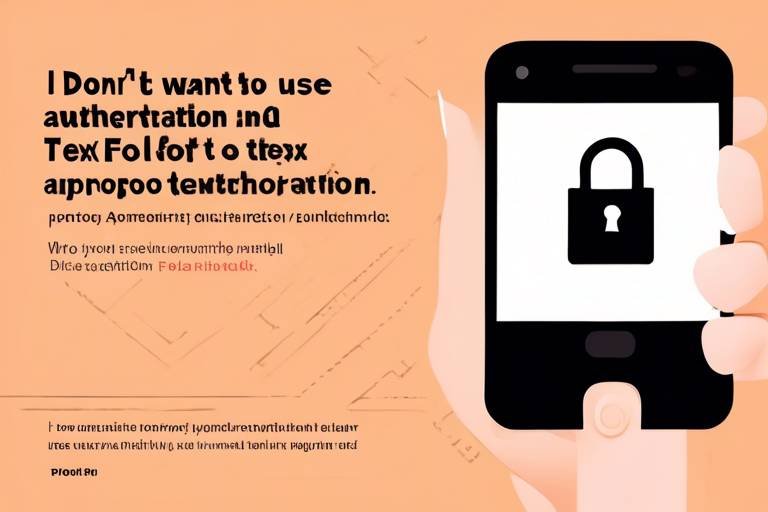How IoT is Changing the Landscape of Cybersecurity
The Internet of Things (IoT) is revolutionizing the way we interact with technology and each other. Imagine a world where your refrigerator can order groceries automatically, your thermostat adjusts based on your daily routine, and your car communicates with traffic signals to optimize your route. This level of connectivity brings with it a myriad of benefits, but it also opens the door to significant challenges in the realm of cybersecurity. As we embrace this new digital era, the question arises: how are we going to protect ourselves from the potential threats that come with it?
With billions of devices expected to be connected to the internet in the coming years, the attack surface for cyber threats is expanding at an alarming rate. Each device, whether it's a smart home gadget or an industrial sensor, represents a potential entry point for cybercriminals. This necessitates a thorough reevaluation of existing security protocols and practices. Organizations must not only protect their traditional IT infrastructure but also secure these interconnected systems that are becoming integral to our daily lives.
As we delve deeper into the world of IoT, it's essential to understand the vulnerabilities that come with these devices. Many IoT products are designed with cost and convenience in mind, often at the expense of robust security features. This means that while we enjoy the conveniences of smart technology, we may inadvertently expose ourselves to cyber threats. So, how do we navigate this complex landscape? The answer lies in adopting proactive cybersecurity measures and fostering a culture of security awareness among users and organizations alike.
In summary, the integration of IoT into our lives is not just a technological advancement; it's a shift that requires us to rethink our approach to cybersecurity. As we explore the challenges and opportunities presented by increased connectivity, it's crucial to stay informed and be prepared to adapt our security strategies to safeguard our digital future.
- What is IoT? The Internet of Things refers to the network of physical devices that are connected to the internet, allowing them to collect and exchange data.
- How does IoT affect cybersecurity? IoT devices expand the potential attack surface for cyber threats, making it essential to implement robust security measures to protect against vulnerabilities.
- What are common vulnerabilities in IoT devices? Common vulnerabilities include weak authentication methods, lack of encryption, and inadequate software updates.
- How can organizations enhance IoT security? Organizations can enhance IoT security by implementing strong authentication protocols, continuous monitoring, and regular software updates.

The Rise of IoT Devices
The Internet of Things (IoT) has rapidly transformed our daily lives, creating a seamless web of interconnected devices that communicate and share data. From smart home appliances like refrigerators and thermostats to wearable fitness trackers, the sheer volume and variety of IoT devices are staggering. According to recent statistics, it's projected that there will be over 30 billion IoT devices by 2030. This explosion of connectivity is not just changing how we interact with technology; it's also reshaping the landscape of cybersecurity in profound ways.
As more devices come online, the attack surface for cyber threats expands exponentially. Each device, whether it's a smart light bulb or a security camera, can potentially serve as an entry point for cybercriminals. This reality necessitates a reevaluation of existing security protocols and practices. Organizations must now consider how to safeguard a multitude of devices that often lack the robust security features we expect from traditional computing systems.
Moreover, the rise of IoT devices has introduced a new level of complexity in managing network security. Unlike traditional IT environments, where devices are often centrally managed and monitored, IoT devices can be dispersed across various locations and networks. This decentralization makes it challenging to implement consistent security measures. For instance, many IoT devices operate on limited processing power and may not support advanced encryption methods, making them susceptible to attacks.
In addition, the user experience often takes precedence over security during the design of these devices. Manufacturers may prioritize ease of use and functionality, which can lead to overlooked security measures. As a result, users may find themselves with devices that are not only vulnerable but also difficult to secure effectively. This is where the responsibility shifts to both manufacturers and consumers to ensure that security isn't an afterthought.
To illustrate the scale of this issue, consider the following table that highlights the growth of IoT devices across various sectors:
| Sector | Projected IoT Devices (in billions) by 2030 |
|---|---|
| Smart Home | 10 |
| Healthcare | 7 |
| Industrial | 5 |
| Transportation | 4 |
| Agriculture | 3 |
This table underscores the significant impact IoT is having across various industries. As organizations increasingly rely on IoT devices for efficiency and innovation, we must also confront the cybersecurity challenges that accompany this growth. The need for robust security frameworks has never been more pressing.
In conclusion, the rise of IoT devices is a double-edged sword. While they offer incredible opportunities for innovation and convenience, they also present significant challenges for cybersecurity. As we continue to embrace this technology, it is crucial to prioritize security measures that can protect our interconnected systems from emerging threats.

Vulnerabilities in IoT Systems
The rapid growth of the Internet of Things (IoT) has brought with it a myriad of benefits, but it has also opened the door to a host of vulnerabilities that can be exploited by cybercriminals. As more devices become interconnected, the potential for security breaches increases dramatically. One of the primary reasons for this heightened risk is the inherent limitations of many IoT devices. Often, these devices are designed with minimal processing power and outdated software, which makes it challenging to implement robust security measures. Imagine trying to fortify a castle with only a few guards; it’s simply not enough to protect against an army of attackers.
Moreover, IoT devices frequently operate in environments where security is not a primary concern. For example, a smart thermostat or a connected refrigerator might not be equipped with the same level of security as a traditional computer. This lack of attention to security creates an attractive target for cybercriminals who are always on the lookout for weaknesses to exploit. The consequences of these vulnerabilities can be severe, ranging from unauthorized data access to complete system takeovers.
Identifying the common security flaws in IoT devices is crucial for developing effective strategies to mitigate risks. Some of the most prevalent vulnerabilities include:
- Weak Authentication: Many IoT devices rely on simple password mechanisms that can be easily guessed or cracked. This lack of robust authentication allows attackers to gain unauthorized access.
- Lack of Encryption: Data transmitted between IoT devices and their controlling applications is often not encrypted, making it easy for hackers to intercept sensitive information.
- Insecure Interfaces: Some IoT devices have poorly designed interfaces that can be manipulated by attackers to gain control over the device.
Each of these flaws represents a significant risk to both individual users and organizations. For instance, poor password practices are alarmingly common. Many users neglect to change default passwords, which are often simple and predictable. This oversight creates an easy entry point for attackers. It’s akin to leaving your front door wide open while you’re away on vacation—inviting trouble without even realizing it.
As mentioned, poor password practices are one of the most significant vulnerabilities in IoT systems. Many devices come with default passwords that users often overlook. This negligence can lead to devastating breaches. In fact, studies have shown that a staggering percentage of IoT devices are still using factory-set passwords. To illustrate this point, consider the following table:
| Device Type | Percentage Using Default Passwords |
|---|---|
| Smart Cameras | 70% |
| Smart Thermostats | 65% |
| Wearable Devices | 50% |
This table highlights the alarming reality that many IoT devices are vulnerable due to users not changing default passwords. It’s essential for users to take proactive steps to secure their devices by implementing strong, unique passwords.
Another critical vulnerability in IoT systems is the failure to regularly update software. Many users neglect this aspect of device maintenance, leaving them exposed to known exploits. Cybercriminals are continuously scanning for devices that have not been updated, as these devices often contain unpatched vulnerabilities that can be easily exploited. Imagine driving a car without ever changing the oil or checking the brakes; eventually, something is bound to go wrong. Similarly, failing to maintain software updates on IoT devices can lead to catastrophic security failures.
In conclusion, while IoT technology offers remarkable advancements, it also poses significant security challenges. Understanding the vulnerabilities inherent in these systems is the first step toward developing effective strategies to safeguard against cyber threats. As we continue to embrace the convenience of IoT, we must remain vigilant and proactive in securing our interconnected world.
- What is the biggest risk associated with IoT devices? The biggest risk is often poor security practices, such as weak passwords and inadequate software updates.
- How can I secure my IoT devices? You can secure your devices by changing default passwords, enabling encryption, and regularly updating software.
- Are all IoT devices vulnerable? While many IoT devices have vulnerabilities, not all are equally at risk. It depends on their design and the security measures implemented.

Common Security Flaws
When it comes to IoT devices, identifying is crucial for anyone looking to enhance their cybersecurity posture. These devices, while incredibly useful, often come with a set of vulnerabilities that can be exploited by malicious actors. One of the most prevalent issues is weak authentication. Many IoT devices are designed with convenience in mind, which often translates to a lack of robust authentication mechanisms. This means that, in many cases, a simple password can be the only line of defense against unauthorized access.
Another significant flaw is the lack of encryption. Data transmitted from IoT devices is frequently unencrypted, making it easy for cybercriminals to intercept sensitive information. Imagine sending a postcard with your personal details written on it—anyone can read it while it’s in transit! This is the reality of many IoT communications today, which is alarming when you consider the sensitive nature of the data being shared.
Additionally, poor password practices are rampant among IoT users. Many devices come with default passwords that are either too simple or widely known. Users often neglect to change these passwords, leaving their devices vulnerable to attacks. A staggering percentage of IoT breaches can be traced back to this single oversight. Here are a few common password-related issues:
- Default passwords not changed by users.
- Simple passwords that can be easily guessed.
- Reused passwords across multiple devices.
Moreover, the issue of inadequate software updates cannot be overlooked. Many IoT manufacturers do not prioritize regular updates, leaving devices susceptible to known vulnerabilities. When users fail to install these updates, they are essentially leaving the door wide open for attackers. In a world where new threats emerge daily, neglecting software maintenance can be a recipe for disaster.
In summary, the landscape of IoT security is fraught with challenges. By understanding and addressing these common security flaws, users and organizations can take significant steps toward safeguarding their networks and data. The key is to stay informed and proactive, ensuring that security measures evolve alongside technological advancements.
Q1: What are the most common security flaws in IoT devices?
A1: The most common security flaws include weak authentication, lack of encryption, poor password practices, and inadequate software updates.
Q2: How can I secure my IoT devices?
A2: You can secure your IoT devices by changing default passwords, enabling encryption, regularly updating software, and using strong, unique passwords for each device.
Q3: Why is encryption important for IoT devices?
A3: Encryption is crucial because it protects sensitive data transmitted by IoT devices from being intercepted and accessed by unauthorized parties.
Q4: What should I do if I suspect my IoT device has been compromised?
A4: If you suspect a compromise, immediately disconnect the device from your network, change passwords, and check for software updates or security patches.

Poor Password Practices
When it comes to securing IoT devices, one of the most glaring oversights is the use of . It's almost like leaving the front door of your house wide open and hoping no one walks in! Many IoT devices come pre-configured with default passwords that are often weak and easily guessable. These passwords are typically listed in the user manuals or can be found online with a simple search. This means that anyone with malicious intent can easily exploit these vulnerabilities.
Imagine this: you buy a smart security camera to keep an eye on your home, but you never bother to change the factory-set password. Before you know it, an intruder could gain access to your camera feed, leaving you vulnerable. In fact, studies have shown that a significant percentage of IoT device users fail to change their default passwords, making it a common security flaw. According to a recent survey, over 80% of consumers do not modify the default settings on their devices, which is a staggering statistic when you consider the potential risks involved.
Moreover, many users opt for simple, memorable passwords instead of creating complex ones, often using easily guessable information such as birthdays or pet names. This is akin to using a “123456” or “password” as your key to the digital world—it's just asking for trouble! To combat this issue, it’s essential for users to adopt better password practices. Here are a few tips to enhance password security:
- Change Default Passwords: Always change the default password to something unique and strong.
- Use Complex Passwords: Combine uppercase letters, lowercase letters, numbers, and symbols to create a strong password.
- Implement Password Managers: Consider using a password manager to generate and store complex passwords securely.
In summary, poor password practices are one of the easiest ways for cybercriminals to gain unauthorized access to IoT devices. By taking a proactive approach to password management, users can significantly reduce the risk of falling victim to cyber threats. Remember, your password is your first line of defense—make it count!
- What are IoT devices? IoT devices are everyday objects that connect to the internet, allowing them to send and receive data.
- Why are poor password practices a problem? They create easy entry points for cybercriminals, making it simple for them to access sensitive information.
- How can I create a strong password? Use a mix of letters, numbers, and symbols, and avoid easily guessable information.
- What should I do if I suspect my IoT device has been compromised? Change your passwords immediately, update your device's software, and monitor your network for any suspicious activity.

Inadequate Software Updates
One of the most significant vulnerabilities in the world of IoT is the issue of . Imagine buying a brand new smartphone and then ignoring all the notifications to update its operating system. It might seem harmless at first, but over time, those ignored updates can leave your device wide open to attacks. This analogy perfectly encapsulates the situation with many IoT devices, which often come with outdated software that is never patched or updated.
The reality is that many IoT devices are deployed in environments where regular maintenance is not prioritized. For instance, consider a smart thermostat installed in a hard-to-reach location. Users might forget about it entirely, which means they also forget to check for software updates. This creates an environment ripe for exploitation, as cybercriminals are always on the lookout for devices that haven’t been fortified with the latest security patches.
Moreover, the manufacturers of these devices sometimes fail to provide a clear update mechanism. Some devices may not have an automatic update feature, leaving users unaware of the necessity to perform manual updates. This lack of awareness can lead to a false sense of security, where users believe their devices are protected simply because they are functioning correctly. In reality, without the latest security measures, these devices can be easily compromised.
To illustrate the impact of inadequate software updates, consider the following table:
| Device Type | Common Vulnerabilities | Impact of Inadequate Updates |
|---|---|---|
| Smart Cameras | Weak encryption, outdated firmware | Unauthorized access to live feeds |
| Wearable Devices | Insecure data transmission | Data breaches, identity theft |
| Smart Home Hubs | Unpatched software vulnerabilities | Control of connected devices by attackers |
As illustrated, the consequences of neglecting software updates can be dire, not just for individual users but also for entire networks. When one device is compromised, it can potentially serve as a gateway for attackers to infiltrate other connected systems. This domino effect highlights the critical need for organizations to implement robust update protocols.
In conclusion, the importance of regular software updates in IoT devices cannot be overstated. Organizations and users alike must prioritize maintaining current security patches to shield against emerging threats. By adopting a proactive approach to software updates, they can significantly reduce the risk of cyber incidents and protect sensitive information from falling into the wrong hands.
- What are the risks of not updating IoT devices? Not updating IoT devices can lead to vulnerabilities that cybercriminals can exploit, resulting in data breaches and unauthorized access.
- How can I ensure my IoT devices are updated? Regularly check the manufacturer's website for updates and enable automatic updates if available.
- Are all IoT devices equally vulnerable? No, the level of vulnerability can vary based on the manufacturer's security practices and the specific features of the device.

Network Security Challenges
The integration of IoT devices into existing networks has transformed the way we think about cybersecurity. With the surge of smart devices—from home assistants to industrial sensors—our networks are more interconnected than ever before. This increased connectivity, while beneficial, has also expanded the attack surface for cyber threats. Imagine a spider web; the more connections there are, the more vulnerable it becomes to a single strike. Therefore, organizations need to be acutely aware of the unique security challenges that arise from this integration.
One of the primary challenges is the sheer volume of devices that need to be managed. Each IoT device can represent a potential entry point for cybercriminals. With thousands, if not millions, of devices connected to a single network, keeping track of each one becomes a Herculean task. This complexity can lead to oversights in security protocols, making it easier for attackers to find and exploit weaknesses.
Moreover, many IoT devices are not designed with security in mind. They often lack robust security features, making them easy targets. For instance, many devices use default settings that are rarely changed by users. This negligence creates a pathway for attackers, who can easily gain access to networks and data. Therefore, organizations must implement stringent security measures right from the onset, ensuring that every device is configured correctly and securely.
Another significant challenge is the lack of visibility into network activity. Traditional network security tools may not be equipped to monitor the vast array of IoT devices effectively. This lack of visibility can lead to delayed detection of suspicious activities, allowing breaches to go unnoticed until significant damage has been done. To combat this, organizations should consider investing in advanced monitoring solutions that are specifically designed for IoT environments.
In addition to these challenges, the dynamic nature of IoT networks means that they are constantly evolving. New devices are added, and existing devices may change their configurations or connections. This fluidity can complicate security measures, as organizations need to continuously adapt their strategies to accommodate these changes. To address this, a proactive approach is essential. Regular assessments of the network, along with updates to security protocols, can help organizations stay one step ahead of potential threats.
In summary, the integration of IoT devices into networks presents numerous security challenges that organizations must navigate carefully. From the sheer volume of devices to the lack of visibility and the dynamic nature of these networks, the road to robust cybersecurity is fraught with obstacles. However, by adopting a proactive and comprehensive security strategy, organizations can mitigate risks and protect their sensitive data from potential breaches.
- What are the main security challenges posed by IoT devices? The main challenges include the increased attack surface, lack of robust security features in many devices, and difficulties in monitoring network activity.
- How can organizations improve their IoT security? Organizations can improve IoT security by implementing strong authentication protocols, conducting regular security assessments, and investing in advanced monitoring solutions.
- Why is visibility important in IoT networks? Visibility is crucial because it allows organizations to detect suspicious activities and respond to potential threats in a timely manner.
- What role does default device settings play in IoT security? Default device settings are often weak and can be exploited by attackers if not changed, making it essential for users to configure devices securely.

Enhancing Cybersecurity Measures
In an age where the Internet of Things (IoT) is becoming an integral part of our daily lives, enhancing cybersecurity measures has never been more crucial. With the increasing number of connected devices, organizations must take proactive steps to safeguard sensitive information and maintain the integrity of their systems. The stakes are high; a single breach can lead to catastrophic consequences, including financial loss and reputational damage. So, how can businesses effectively fortify their defenses against the ever-evolving landscape of cyber threats?
First and foremost, implementing strong authentication protocols is essential. Relying solely on traditional username and password combinations is no longer sufficient. Organizations should consider integrating multi-factor authentication (MFA), which requires users to provide two or more verification factors—something they know (password), something they have (a smartphone app), or something they are (biometric data). This layered approach significantly reduces the risk of unauthorized access, making it exponentially harder for cybercriminals to infiltrate systems.
Moreover, device-specific credentials should be utilized to enhance security further. By assigning unique credentials to each IoT device, organizations can monitor access more effectively and detect any suspicious activity. This means that if one device is compromised, the impact can be contained, preventing a domino effect that could jeopardize the entire network.
Another critical aspect of enhancing cybersecurity is the establishment of continuous monitoring and threat detection systems. In a world where cyber threats can emerge at any moment, having real-time visibility into network activities is paramount. Organizations should invest in advanced monitoring tools that can analyze traffic patterns, identify anomalies, and alert security teams to potential threats. By acting swiftly, businesses can minimize the impact of cyber incidents and protect their valuable data.
In addition to these measures, it’s vital to foster a culture of cybersecurity awareness among employees. After all, even the most advanced security systems can be undermined by human error. Regular training sessions on recognizing phishing attempts, safe browsing practices, and the importance of strong passwords can empower employees to be the first line of defense against cyber threats. A well-informed workforce is a formidable ally in the fight against cybercrime.
Furthermore, organizations should not overlook the importance of regular security audits. Conducting comprehensive assessments of existing security measures helps identify vulnerabilities and areas for improvement. These audits can be performed internally or by third-party experts who specialize in cybersecurity. By regularly reviewing and updating security protocols, businesses can stay ahead of potential threats and ensure that their defenses are always robust.
Finally, it’s essential to have a well-defined incident response plan in place. In the unfortunate event of a cyber breach, having a clear roadmap can make all the difference. This plan should outline the steps to take, including how to contain the breach, communicate with stakeholders, and recover lost data. By being prepared, organizations can respond swiftly and effectively, minimizing the damage and restoring normal operations as quickly as possible.
In conclusion, enhancing cybersecurity measures in the age of IoT is not just a best practice; it's a necessity. By implementing strong authentication protocols, continuous monitoring, employee training, regular audits, and having an incident response plan, organizations can significantly reduce their risk of falling victim to cyber threats. As technology continues to advance, so too must our efforts to protect it.
- What is multi-factor authentication? Multi-factor authentication is a security process that requires users to provide two or more verification factors to gain access to a system, making it harder for unauthorized users to access sensitive information.
- Why is continuous monitoring important? Continuous monitoring allows organizations to detect and respond to suspicious activities in real-time, minimizing the potential impact of cyber incidents.
- How often should security audits be conducted? Security audits should be conducted regularly, at least annually, or whenever significant changes are made to the network or security protocols.

Implementing Strong Authentication
In the ever-evolving world of the Internet of Things (IoT), strong authentication is not just a luxury; it's a necessity. With the increasing number of devices connected to the internet, each device becomes a potential gateway for cybercriminals. Imagine your smart thermostat or security camera being hacked; it’s not just about losing control over a device, but it could also mean compromising your entire network. Therefore, implementing robust authentication mechanisms is crucial for protecting sensitive data and maintaining the integrity of connected systems.
One of the most effective strategies for enhancing security is the use of multi-factor authentication (MFA). This method requires users to provide two or more verification factors to gain access to a device or network, significantly reducing the risk of unauthorized access. For instance, in addition to a password, a user might need to enter a code sent to their mobile device. This extra layer of security makes it much harder for attackers to gain entry, even if they manage to obtain a user's password.
Furthermore, device-specific credentials play a pivotal role in securing IoT devices. Each device should have unique authentication details rather than relying on a universal password. This approach minimizes the risk of a single compromised password leading to a domino effect across multiple devices. Implementing strong password policies is essential, which includes encouraging users to create complex passwords that are difficult to guess. For example, a good password should include a mix of uppercase letters, lowercase letters, numbers, and special characters. Here’s a brief comparison table to illustrate the difference:
| Password Type | Security Level |
|---|---|
| Simple Password (e.g., "123456") | Low |
| Moderate Password (e.g., "Password123!") | Medium |
| Complex Password (e.g., "G7!kL2#z@9tQ") | High |
Adopting these practices not only fortifies the security of IoT devices but also fosters a culture of cybersecurity awareness among users. It’s essential for organizations to educate their employees and customers about the importance of these measures. Regular training sessions can help users recognize the significance of strong authentication and how to implement it effectively.
In conclusion, as IoT devices become more integrated into our daily lives, the need for strong authentication practices will only grow. By leveraging multi-factor authentication, device-specific credentials, and fostering a culture of security awareness, organizations can significantly enhance their defenses against potential cyber threats. Remember, in the realm of cybersecurity, an ounce of prevention is worth a pound of cure.
- What is multi-factor authentication? - It is a security process that requires more than one form of verification to access a device or network.
- Why is strong authentication important for IoT devices? - It helps prevent unauthorized access, protecting sensitive information and maintaining system integrity.
- How can I create a strong password? - Use a mix of uppercase letters, lowercase letters, numbers, and special characters to create a complex password.

Continuous Monitoring and Threat Detection
In the fast-paced world of the Internet of Things (IoT), the need for continuous monitoring and threat detection has never been more critical. As organizations increasingly integrate smart devices into their operations, the potential for cyber threats escalates. Imagine a bustling city where traffic lights, public transport, and even streetlights are interconnected; a single breach can disrupt the entire system. This is why establishing robust monitoring systems is essential.
Continuous monitoring involves real-time surveillance of IoT networks to identify suspicious activities and potential threats before they escalate into serious incidents. By implementing advanced analytics and machine learning algorithms, organizations can sift through vast amounts of data generated by IoT devices. This allows for the detection of anomalies that may indicate a security breach. For instance, if a smart thermostat suddenly starts sending unusually frequent data packets, it could signal a compromise that needs immediate attention.
Moreover, the integration of threat detection systems can automate the response to identified threats, enabling organizations to act swiftly. These systems can be programmed to isolate affected devices, alert security personnel, and even initiate predefined response protocols. This capability is akin to having a fire alarm system in your home; it detects smoke and triggers an immediate response, preventing a small issue from becoming a catastrophic fire.
To effectively implement continuous monitoring and threat detection, organizations should consider the following key components:
- Data Collection: Gather data from all IoT devices, ensuring a comprehensive view of the network.
- Real-Time Analytics: Use analytics tools to process data and identify patterns that may indicate a security threat.
- Incident Response Plans: Develop clear protocols for responding to detected threats, ensuring that all team members know their roles.
In addition, organizations should invest in training their staff on the importance of cybersecurity hygiene. Employees should be aware of how to recognize potential threats and report them promptly. Regular training can empower staff, making them the first line of defense against cyber threats.
Finally, the effectiveness of continuous monitoring and threat detection hinges on collaboration. Organizations should work closely with cybersecurity experts and leverage the latest technologies to stay ahead of malicious actors. As cyber threats evolve, so too must our strategies for combating them. By fostering a culture of vigilance and proactive security measures, businesses can significantly reduce their risk exposure in the IoT landscape.
- What are the benefits of continuous monitoring in IoT security?
Continuous monitoring helps identify threats in real-time, allowing for quicker responses and minimizing potential damage. - How can organizations implement effective threat detection?
By using advanced analytics and machine learning, organizations can analyze data from IoT devices to detect anomalies and potential threats. - What role does employee training play in IoT cybersecurity?
Training employees on cybersecurity best practices enhances their ability to recognize and report potential threats, making them a crucial part of the security framework.

The Future of IoT and Cybersecurity
As we look ahead, the future of IoT and cybersecurity is poised for dramatic transformation. With the rapid advancement of technology, we are witnessing an explosion of smart devices that permeate our daily lives, from smart home appliances to industrial IoT systems. While this connectivity brings unparalleled convenience and efficiency, it also introduces a host of complexities and challenges in the realm of cybersecurity. Imagine a world where your refrigerator can order groceries or your car can communicate with traffic lights; these innovations are not just dreams anymore, but they also raise critical questions about how secure these systems truly are.
One of the most pressing issues is the sheer volume of devices that will be connected to the internet. It is projected that by 2030, there will be over 30 billion IoT devices worldwide. This astronomical increase in connectivity expands the attack surface for cybercriminals, making it essential for organizations to adopt a proactive approach to cybersecurity. In this scenario, traditional security measures may not suffice. Instead, we will need to embrace adaptive security frameworks that can evolve in real-time to counteract emerging threats.
Moreover, the integration of artificial intelligence (AI) and machine learning into IoT security systems is set to revolutionize how we protect our networks. These technologies can analyze vast amounts of data to identify patterns and anomalies that human analysts might miss. For instance, AI can detect unusual traffic patterns that may indicate a cyber attack, allowing organizations to respond swiftly before any significant damage occurs. This is akin to having a vigilant guard who never sleeps, always on the lookout for potential intruders.
However, with these advancements come new vulnerabilities. As IoT devices become more sophisticated, so too do the tactics employed by cybercriminals. Future threats may involve advanced persistent threats (APTs) that target multiple IoT devices simultaneously, creating a chain reaction of vulnerabilities. This interconnectedness means that a breach in one device could potentially compromise an entire network, raising the stakes for cybersecurity measures.
To address these challenges, organizations must prioritize the implementation of robust security protocols. This includes not only securing devices at the hardware and software levels but also ensuring that data transmitted between devices is encrypted. For example, utilizing blockchain technology can provide a decentralized and tamper-proof method for securing IoT communications, significantly reducing the risk of data breaches.
As we forge ahead, collaboration between manufacturers, developers, and cybersecurity experts will be crucial. Establishing industry standards and best practices will help create a more secure IoT ecosystem. Additionally, educating consumers about the importance of cybersecurity in their everyday devices is essential. Just as we lock our doors at night, we must also take steps to secure our digital lives.
In summary, the future of IoT and cybersecurity is a double-edged sword. While the potential for innovation is limitless, so too are the risks associated with increased connectivity. As we embrace this new era, it is imperative that we remain vigilant and adaptable, constantly evolving our security strategies to meet the challenges that lie ahead.
- What are some common IoT devices that pose cybersecurity risks?
Common devices include smart home assistants, connected cameras, and industrial sensors.
- How can individuals secure their IoT devices?
Changing default passwords, enabling two-factor authentication, and keeping software updated are essential steps.
- What role does AI play in IoT cybersecurity?
AI can monitor network traffic for unusual patterns, helping to identify potential threats before they escalate.
- Will regulations impact IoT cybersecurity?
Yes, as governments recognize the risks, we can expect more regulations aimed at strengthening IoT security protocols.
Frequently Asked Questions
- What is the Internet of Things (IoT)?
The Internet of Things (IoT) refers to the network of interconnected devices that communicate and exchange data with each other over the internet. These devices can range from everyday household items like smart thermostats and refrigerators to industrial machines and sensors, all designed to enhance efficiency and convenience.
- How does IoT impact cybersecurity?
The rise of IoT devices significantly expands the attack surface for cyber threats. With more devices connected to the internet, there are more potential entry points for cybercriminals. This necessitates a reevaluation of existing security protocols to protect these interconnected systems effectively.
- What are common vulnerabilities in IoT devices?
Common vulnerabilities in IoT devices include weak authentication methods, inadequate encryption, and poor software update practices. Many devices come with default passwords that users often forget to change, making them easy targets for hackers looking to gain unauthorized access.
- How can organizations enhance IoT cybersecurity?
Organizations can enhance IoT cybersecurity by implementing strong authentication protocols, such as multi-factor authentication, and ensuring continuous monitoring of their networks. Regularly updating software and conducting security audits are also critical steps in safeguarding sensitive data.
- What role do software updates play in IoT security?
Software updates are crucial for maintaining the security of IoT devices. Many vulnerabilities are discovered over time, and manufacturers release updates to patch these issues. Failing to apply these updates can leave devices exposed to known exploits and cyber threats.
- What is network segmentation, and why is it important for IoT?
Network segmentation involves dividing a network into smaller, manageable sections to improve security. For IoT devices, this means isolating them from critical systems, which helps contain potential breaches and reduces the risk of widespread damage in case of an attack.
- What is the future of IoT and cybersecurity?
As IoT technology continues to evolve, the challenges it poses for cybersecurity will also grow. Organizations must continuously innovate and adapt their security practices to address emerging threats and vulnerabilities, ensuring that they stay one step ahead of cybercriminals.



















